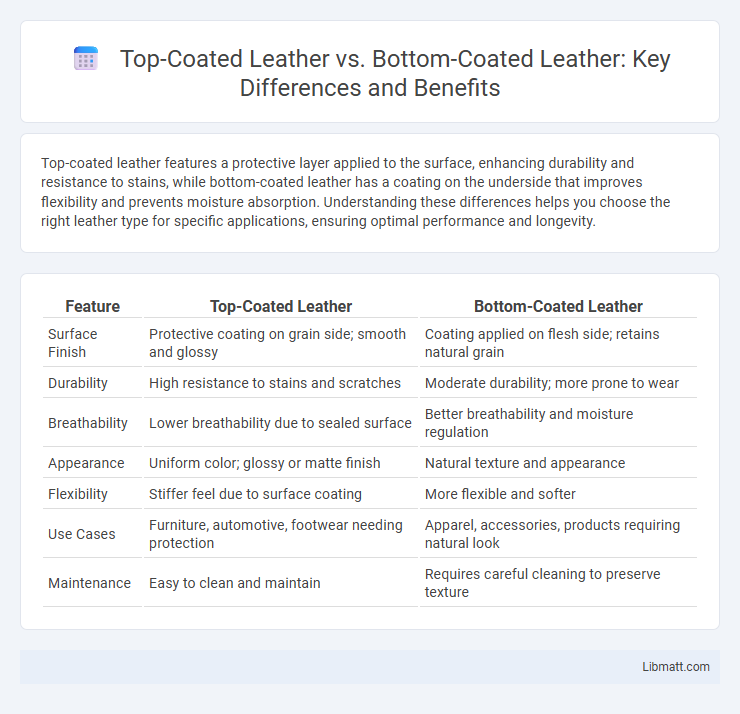Top-coated leather features a protective layer applied to the surface, enhancing durability and resistance to stains, while bottom-coated leather has a coating on the underside that improves flexibility and prevents moisture absorption. Understanding these differences helps you choose the right leather type for specific applications, ensuring optimal performance and longevity.
Table of Comparison
| Feature | Top-Coated Leather | Bottom-Coated Leather |
|---|---|---|
| Surface Finish | Protective coating on grain side; smooth and glossy | Coating applied on flesh side; retains natural grain |
| Durability | High resistance to stains and scratches | Moderate durability; more prone to wear |
| Breathability | Lower breathability due to sealed surface | Better breathability and moisture regulation |
| Appearance | Uniform color; glossy or matte finish | Natural texture and appearance |
| Flexibility | Stiffer feel due to surface coating | More flexible and softer |
| Use Cases | Furniture, automotive, footwear needing protection | Apparel, accessories, products requiring natural look |
| Maintenance | Easy to clean and maintain | Requires careful cleaning to preserve texture |
Introduction to Coated Leather Types
Top-coated leather features a protective finish applied to the surface, enhancing durability, water resistance, and aesthetic appeal with a smooth, glossy appearance. Bottom-coated leather is treated on the underside, improving grip and stability without altering the outer texture, making it ideal for functional uses like upholstery. Understanding these differences helps you choose the right leather type for your specific needs, whether prioritizing appearance or performance.
What Is Top-Coated Leather?
Top-coated leather features a protective finish applied to the surface, enhancing durability, water resistance, and stain protection while maintaining a natural leather appearance. This coating improves the leather's resistance to wear and fading, making it suitable for high-use items like furniture and automotive interiors. The topcoat allows for easier cleaning and longer-lasting aesthetics without compromising the material's breathability.
Understanding Bottom-Coated Leather
Bottom-coated leather features a layer of polymer applied to the flesh side, enhancing its durability and water resistance while maintaining flexibility. This treatment improves the leather's protection against wear and environmental damage, making it ideal for items exposed to frequent use or moisture. Understanding bottom-coated leather helps you select materials that balance durability with aesthetic appeal for your specific needs.
Key Differences: Top-Coated vs Bottom-Coated Leather
Top-coated leather features a protective finish applied on the outer surface, enhancing durability, water resistance, and aesthetic appeal by preserving the grain texture. Bottom-coated leather has a coating on the backside, primarily for added structural support, moisture barrier, and increased longevity without altering the natural leather grain on the visible side. The key differences lie in surface treatment location and functional benefits: top coating improves exterior resilience and appearance, while bottom coating reinforces backing strength and stability.
Durability Comparison
Top-coated leather features a surface layer that enhances its resistance to scratches, stains, and wear, making it more durable for everyday use compared to bottom-coated leather. Bottom-coated leather, with its finish applied underneath the surface, tends to be less protected against abrasion and may show signs of wear more quickly. Your choice should consider the higher durability of top-coated leather for products exposed to frequent handling or harsh conditions.
Visual Appearance and Texture
Top-coated leather features a smooth, polished surface with a glossy finish that enhances color depth and provides a luxurious appearance. Bottom-coated leather displays a more natural, matte texture with visible grain patterns, emphasizing durability and a rugged, authentic look. The top coat enhances water resistance and ease of cleaning, while bottom-coated leather offers a softer, more breathable feel.
Maintenance and Care Requirements
Top-coated leather features a durable finish that resists stains and moisture, making it easier to clean with a damp cloth and mild soap, requiring less frequent conditioning. Bottom-coated leather, lacking this protective layer, absorbs oils and dirt more readily, necessitating regular moisturizing with leather conditioners to prevent drying and cracking. Proper maintenance of both types involves avoiding prolonged exposure to direct sunlight and humidity to preserve texture and color.
Common Applications and Uses
Top-coated leather features a durable, glossy finish ideal for high-end fashion items, upholstery, and automotive interiors where aesthetic appeal and protection are essential. Bottom-coated leather typically serves in industrial applications and heavy-duty goods like safety footwear and equipment straps due to its enhanced resistance to abrasion and moisture. Your choice depends on whether you prioritize surface appearance or functional durability in the leather's end use.
Pros and Cons of Each Leather Type
Top-coated leather features a protective finish that enhances durability, water resistance, and ease of cleaning, making it ideal for everyday items, but it may lack breathability and natural texture. Bottom-coated leather provides a softer, more natural feel with better breathability, offering superior comfort and aging characteristics, though it is more susceptible to stains, scratches, and requires more maintenance. Understanding the pros and cons of each type helps you choose the right leather based on durability needs, aesthetic preferences, and care considerations.
Choosing the Right Leather for Your Needs
Top-coated leather offers a smooth, glossy finish that enhances durability and resists stains, making it ideal for fashion items and upholstery requiring a polished appearance. Bottom-coated leather features a protective layer on the reverse side, providing added strength and water resistance, suitable for heavy-duty uses like footwear and outdoor gear. Selecting the right leather depends on prioritizing surface aesthetics with top-coated options or seeking enhanced structural protection with bottom-coated varieties.
Top-coated leather vs bottom-coated leather Infographic

 libmatt.com
libmatt.com